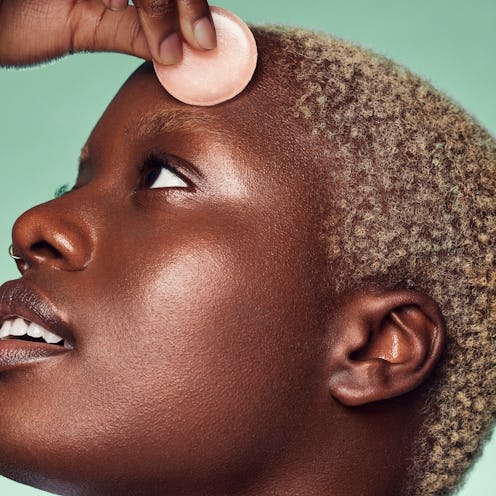(Skin)
Can You Ice Your Way To Better Skin?
Refreshing and soothing.

Face icing is the ultimate additive to your facial or at-home routine this winter as it helps to instantly calm inflammation, reduce pore size, and even get rid of redness. And while experts say this practice of applying ice to your skin traces back to Cleopatra, it’s recently gone viral. Why now? Dr. Dendy Engelman, M.D., a board-certified dermatologist and MOHS surgeon at Shafer Clinic in New York City, says that while this concept has been around for ages, many skin care trends tend to get “repackaged” as the next generation is introduced to these beauty tips and tricks. “Social media plays a large part in this as well, with microtrends surging across TikTok and Instagram every day, coining old practices with fresh, catchy names,” she says.
While some beauty fads seem utterly ridiculous (#preshowermakeup, anyone?), face icing is truly a beneficial way to level up your skin care. Joanna Czech, celebrity esthetician and founder of Joanna Czech Skincare, is thrilled to see face icing re-surfacing in the mainstream, although she says it’s best to exercise a bit of precaution. “Like most new additions to your beauty routine, it’s important to be educated and not to be exaggerated and go crazy,” she says.
Read on for expert advice on how to incorporate face icing into your regimen.
How Face Icing Works
Sofie Pavitt, celebrity facialist and founder of Sofie Pavitt Face, says that when you sprain your ankle or get an injury, you’re told to ice that area to reduce swelling and inflammation. Well, face icing leans into the same concept. “The cold temperature lowers inflammation and swelling and also reduces the heat in the skin,” she says. “Hyperpigmentation can be caused by this kind of heat, so icing can be especially beneficial if you suffer from pigmentation or even the dreaded melasma.”
Dr. Engelman agrees that face icing is an easy, effective, and affordable way to reduce swelling and puffiness (especially in the morning). However, she says practicing it in the morning also has other perks. “It can also create a brightening effect by restricting the blood vessels, thus closing the pores for radiant-looking skin.”
Ways To Ice Your Face
The way you ice really depends on your preference for application, but Dr. Engelman makes a case for ice rollers. “Some people prefer using an ice roller as it can be more convenient and less messy than using ice cubes — plus, they can stay colder for longer, and can provide a more consistent application,” she says. However, she adds that ice cubes are obviously great as they are virtually no cost. “If you plan to use an ice cube, however, I recommend wrapping it in a paper towel, cloth, or even a Ziploc bag to protect your skin — and always massage it in circular motions.”
Czech’s approach is a bit more creative as she says that freezing certain liquids will provide even more benefits. For instance, she says that making ice cubes out of milk is like a “milk bath for your face” and really helps to soothe skin. “I also recommend making cubes out of dandelion tea, [which has the ability] to de-puff,” she adds. She also loves to practice face icing during her treatments after stimulating facial muscles through microcurrent, as it almost “freezes” the definition she created. And finally, when it comes to face dunking — “not the most elegant term,” she jokes — Czech says that simply splashing with cold water will not only close pores but will feel invigorating, two reasons to incorporate the quick practice into your morning routine.
Upping the ante, Pavitt created her own face icing method with her Nice Ice Toner Pods because she wanted to incorporate active ingredients into her clients’ icing routines. “We created these individually wrapped cryo-toning treatments that contain ashwagandha, niacinamide, green tea extract, and glycerin to calm irritation, increase circulation, and decrease inflammation,” she says. “You store them in the freezer and can use them as part of your toning step, after med spa treatments such as laser, Botox, or microneedling, or any time you have a painful breakout that you want to calm down.”
What To Keep In Mind When Face Icing
All of the experts agree that you have to be careful when using ice directly on the skin. “You don’t want to hold ice in position on the skin, but rather move it in circular motions and keep it moving,” says Pavitt. “Or you can even apply with a cotton round sandwiched around it to bring down swelling on say a pustule or cystic breakout.” Czech strongly agrees. “You can actually create micro-frost if you don’t continually move the ice or tool around the skin — just be sure you slide it across the face and keep it moving.” She also suggests laying down a sheet mask first, as the quality of the skin on your face is different than that of your elbow, which is why you need to protect it with some sort of barrier.
When it comes to skin types, those with sensitive skin should check in with a doctor to make sure face icing is a good idea. Since extreme cold can trigger some forms of rosacea, those who suffer from the condition should be careful about excessive Icing. “However, subtype two rosacea (a form of acne) can actually benefit from it, in my opinion,” says Pavitt.
The bottom line? Face icing can be a refreshing and beneficial addition to your skin care routine.
This article was originally published on